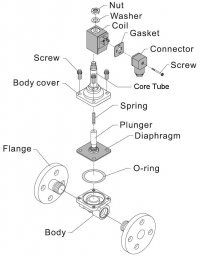News Letter
Sign Up & get 33% off your first order
Enter your preferred name & e-mail to subscribe

|
1. Installation Before mounting the valve, it is necessary to check that the solenoid valve model, the voltage (Volt) and the frequency (Hz) correspond to the characteristics required. |
|
2. Mechanical part Assembly of the solenoid valve must correspond with the flow direction indicated with an arrow on the valve body, in some cases this can be indicated by a 1 (input) and a 2 (output).
If the valves are provided with caps for protecting the connections, make sure that you remove them before assembly.
Care should be taken to prevent foreign bodies from entering the valve during the assembly phase, e.g. dirt, material chips or particles of insulating material such as PTFE tape from the "external thread" connections.
Although the valve can be used in any position, the inverted positions are not advised since possible impurities could become blocked inside the tube, causing a malfunction.
When installing the valve/valves, make sure that the position and surrounding space are sufficient to allow for possible future maintenance or replacement of the coil.
Never use part of the tube or coil itself as a lever during the tightening phase: this could cause irreparable damage to the valve.
In those installations where impurities, slag or deposits of various types may infiltrate the fluid, it is advisable to mount a filter upstream of the valve.
In case of solenoid valves with holes drilled for supports, use must be made exclusively of these without modifying the holes or anything else on the valve body in order for the valve to run correctly.
For solenoid valves with connections to be welded, please refer to paragraph 4. |
|
3. Electrical Connections
Before connecting the coil to the supply system, make sure that the characteristics conform to the supply voltage.
Where applicable, the earth terminal has to be connected.
The coil should not be energised before being installed on the valve, since this could cause it to burn out.
Rotate the coil to the most suitable position, loosening and subsequently tightening the upper nut. |
|
4. Working Temperature
It is normal for the coil temperature to increase during operation; irregular overheating will cause smoke and smell of burning. In this case, the power supply must be immediately isolated.
Care should be taken not to install the valve near a source of heat or in environments where there could be a disruption to the dissipation of heat produced by the coil.
For special conditions, e.g. high temperatures or particular safety regulation, please consult our catalogue or our technical office.
Particular attention should be paid to the temperatures when installing valves with welded connections.
When carrying out welding between the valve connection and the pipe system, it is necessary to dismantle the coil and check that the temperature of the valve body does not exceed values of 100 C- 150 C (200 F -300 F). The flame should be regulated so that it does not come into contact with the valve. It is advisable to cool the valve body by warping it in a wet cloth. Should it be impossible to carry out their precautions, we suggested dismantling the parts inside the valve. |
|
5. Maintenance
After disconnecting the supply voltage and discharging the pressure, carry out inspection of the valve.
Clean and inspect all the internal parts and replace them if necessary with type original spare parts available, as indicated in the catalogue.
Remount all the parts, making up the solenoid valve with care, paying great attention to the correct position of each part and protecting the stealing surfaces.
Check for tightness and correct operation.
These general instructions give an approximate issued of the correct use of the solenoid valves, but cannot in any way be considered as a substitute for the catalogue giving all the characteristics of every solenoid valve. Please consult this volume or our technical office for every near installation.
|


A catalouge of articles covering all aspects of solenoid valves
Enter your preferred name & e-mail to subscribe